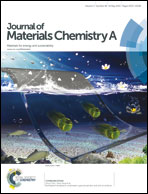Two-dimensional ultrathin ZnCo2O4 nanosheets: general formation and lithium storage application†
Abstract
Two-dimensional (2D) multicomponent transition-metal oxide nanosheets are the most promising candidate in low-cost and eco-friendly energy storage/conversion applications. Their surface-enhanced properties and synergic effects are fascinating, yet still underdeveloped. Here, we first report the high-quality ultrathin 2D nanosheets of ZnCo2O4 synthesized on a large scale via microwave-assisted liquid-phase growth coupled with a post annealing procedure. The well-defined and freestanding nanosheets exhibit a micron-sized planar area and ultrathin thickness, suggesting a high surface atom ratio with an unique surface and electronic structure, thus facilitating the charge transfer to enhance the overall performances in electrochemical reaction. When used as anode materials for lithium ion batteries, the ultrathin ZnCo2O4 nanosheets exhibit a high reversible lithium storage capacity of 930–980 mA h g−1 at 200 mA g−1 current density in 200 cycles with an excellent cycling stability and good high-rate capability. Even more importantly, we have extended the facile method for the formation of other analogue nanosheets including binary and ternary transition metal oxides (NiO, Co3O4, NiCo2O4, and CuCo2O4) and make a possibility in exploring more unique properties and promising commercial applications.


 Please wait while we load your content...
Please wait while we load your content...